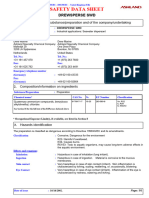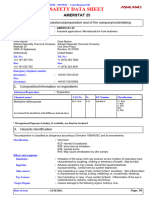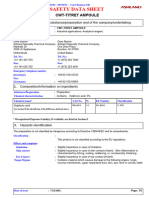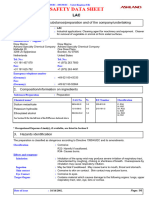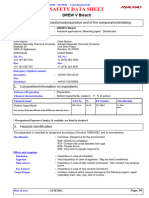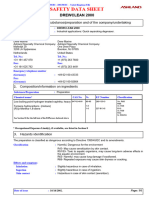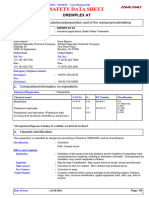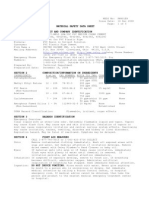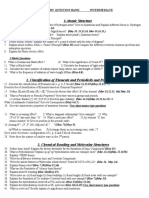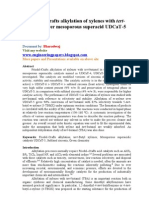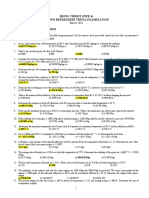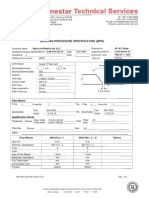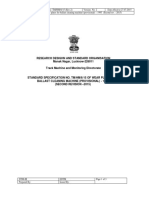0076 Fi41c5kub
0076 Fi41c5kub
Uploaded by
Nandar Min HtetCopyright:
Available Formats
0076 Fi41c5kub
0076 Fi41c5kub
Uploaded by
Nandar Min HtetOriginal Title
Copyright
Available Formats
Share this document
Did you find this document useful?
Is this content inappropriate?
Copyright:
Available Formats
0076 Fi41c5kub
0076 Fi41c5kub
Uploaded by
Nandar Min HtetCopyright:
Available Formats
Conforms to 91/155/EEC - 2001/58/EC - United Kingdom (UK)
SAFETY DATA SHEET
AMERSPERSE 280
1. Identification of the substance/preparation and of the company/undertaking
Product name : AMERSPERSE 280
Material Uses : Industrial applications: Microbiocide for cooling water treatment
Manufacturer / Supplier :
Drew Marine Drew Marine
Ashland Specialty Chemical Company Ashland Specialty Chemical Company
Malledijk 20 One Drew Plaza
3208 LA Spijkenisse Boonton, NJ 07005
Netherlands United States
Tel. No.: Tel. No.:
+31 181 457 070 +1 (973) 263 7600
Fax: Fax:
+31 181 625 792 +1 (973) 263 4491
Emergency telephone number
(Germany) : +49 621 60-43333
Fax:
(Germany) : +49 621 60-92664
2. Composition/information on ingredients
Substance/Preparation : Preparation
Chemical name* CAS No. % EC Number Classification
Sodium dimethyldithiocarbamate 128-04-1 10-20 204-876-7 Xn; R21/22
Disodium ethylenebis(N,N'-dithiocarbamate 142-59-6 10-20 205-547-0 Xn; R22
Xi; R37
R43
N; R50/53
See Section 16 for the full text of the R Phrases declared above
* Occupational Exposure Limit(s), if available, are listed in Section 8
3. Hazards identification
The preparation is classified as dangerous according to Directive 1999/45/EC and its amendments.
Classification : Harmful, Dangerous for the environment
R22- Harmful if swallowed.
R43- May cause sensitization by skin contact.
R50/53- Very toxic to aquatic organisms, may cause long-term adverse effects
in the aquatic environment.
Effects and symptoms
Skin contact : Hazardous in case of skin contact (sensitizer).
Date of issue : 10/16/2002. Page: 1/5
AMERSPERSE 280
4. First-aid measures
First-Aid measures
Inhalation : If inhaled, remove to fresh air. If not breathing, give artificial respiration. If
breathing is difficult, give oxygen. Obtain medical attention.
Ingestion : Do NOT induce vomiting unless directed to do so by medical personnel.
Never give anything by mouth to an unconscious person. If large quantities of
this material are swallowed, call a physician immediately. Loosen tight clothing
such as a collar, tie, belt or waistband.
Skin contact : In case of contact, immediately flush skin copiously with water for at least 15
minutes while removing contaminated clothing and shoes. Cold water may be
used. Wash clothing before reuse. Clean shoes thoroughly before reuse.
Obtain medical attention.
Eye Contact : Check for and remove any contact lenses. In case of contact, immediately
flush eyes with a copious amount of water for at least 15 minutes. Cold water
may be used. Obtain medical attention.
5. Fire-fighting measures
Extinguishing Media
Suitable : Not applicable.
Hazardous thermal (de)composition : These products are carbon oxides (CO, CO2) and water, nitrogen oxides (NO,
products NO2...), sulphur oxides (SO2, SO3, etc.). Dimethylamine , Hydrogen Cyanide
(HCN) ,CS2
Protection of fire-fighters : Fire fighters should wear self-contained positive pressure breathing apparatus
(SCBA) and full turnout gear.
6. Accidental release measures
Personal Precautions : Splash goggles. Full suit. Boots. Gloves.
Environmental precautions and : Absorb with an inert material and put the spilled material in an appropriate
cleanup methods waste disposal. Neutralize the residue with a dilute solution of acetic acid.
Note: See section 8 for personal protective equipment and section 13 for waste disposal.
7. Handling and storage
Handling : Do not breathe gas/fumes/vapour/spray. Wear suitable protective clothing. If
ingested, seek medical advice immediately and show the container or the
label. Keep away from incompatibles such as oxidizing agents, acids.
Storage : Keep container tightly closed. Keep container in a cool, well-ventilated area.
Packaging materials
Recommended use : Use original container.
8. Exposure controls/personal protection
Engineering measures : Provide exhaust ventilation or other engineering controls to keep the airborne
concentrations of vapours below their respective occupational exposure limits.
Hygiene measures : Wash hands, forearms, and face thoroughly after handling compounds and
before eating, smoking, using lavatory, and at the end of day.
Date of issue : 10/16/2002. Page: 2/5
AMERSPERSE 280
Respiratory system : Wear appropriate respirator when ventilation is inadequate.
Skin and body : Lab coat.
Hands : Impervious gloves.
Eyes : Safety glasses.
9. Physical and chemical properties
Physical state : Liquid.
Colour : Yellow / Green
Odour : Rotten eggs.
Boiling point : 100°C (212°F)
Melting point : <0°C (32°F)
Density : 1.17 g/cm3
Vapour pressure : The highest known value is 2.33 kPa (17.5 mmHg) (at 20°C) (Water).
Evaporation Rate : <1 compared to Ether (anhydrous).
Solubility : Easily soluble in cold water.
pH : 9 to 11 [Basic.]
Flash point : Not applicable.
10. Stability and reactivity
Stability : The product is stable.
Conditions to Avoid : Exposure to heat
Materials to avoid : Reactive with oxidizing agents, acids.
Incompatible with: acids , oxidizing agents
Hazardous decomposition products : These products are carbon oxides (CO, CO2) and water, nitrogen oxides (NO,
NO2...), sulphur oxides (SO2, SO3, etc.). Dimethylamine , Hydrogen Cyanide
(HCN) ,CS2
11. Toxicological information
Acute toxicity
Ingredient Name Test Result Route Species
Sodium dimethyldithiocarbamate LD50 300 mg/kg Oral Rabbit
LD50 1500 mg/kg Oral Mouse
LD50 1000 mg/kg Oral Rat
LD50 >1150 Dermal Rabbit
mg/kg
Disodium ethylenebis(N,N'-dithiocarbamate) LD50 395 mg/kg Oral Rat
LD50 580 mg/kg Oral Mouse
Chronic toxicity : Repeated or prolonged exposure is not known to aggravate medical condition.
Sensitization : Hazardous in case of skin contact (sensitizer).
Carcinogenic effects : Not available.
Mutagenic Effects : Not available.
Reproduction toxicity : Not available.
Date of issue : 10/16/2002. Page: 3/5
AMERSPERSE 280
12. Ecological information
Ecotoxicity Data
Ingredient Name Species Period Result
AMERSPERSE 280 Fish (LC50) 96 hours 0.1 to 0.3 mg/l
Persistence/degradability : Not available.
13. Disposal considerations
Methods of disposal ; Waste of : Waste must be disposed of in accordance with federal, state and local
residues ; Contaminated packaging environmental control regulations.
European Waste Catalogue (EWC) : 07 04 00
Hazardous Waste : The classification of the product may meet the criteria for a hazardous waste.
Additional Information : 07 04 00 waste from the MFSU of organic pesticides (except 02 01 05)
14. Transport information
International transport regulations
Land - Road/Railway
UN number : 3082
Proper shipping name : ENVIRONMENTALLY HAZARDOUS SUBSTANCE, LIQUID, N.O.S.
(NABAM)
ADR/RID Class : 9
Packing group : -
ADR/RID label :
Other information : Hazard identification number
90
Sea
UN number : 3082
Proper shipping name : ENVIRONMENTALLY HAZARDOUS SUBSTANCE, LIQUID, N.O.S.
(NABAM)
IMDG Class : 9
Packing group : -
IMDG label :
Other information : Emergency Schedules (EmS)
6.1-02
Marine pollutant
IMDG Class: Marine Pollutant. (Pollutant.)
Date of issue : 10/16/2002. Page: 4/5
AMERSPERSE 280
15. Regulatory information
EU Regulations
Hazard symbol(s) :
Harmful, Dangerous for the environment
Risk Phrases : R22- Harmful if swallowed.
R43- May cause sensitization by skin contact.
R50/53- Very toxic to aquatic organisms, may cause long-term adverse effects
in the aquatic environment.
Safety Phrases : S24- Avoid contact with skin.
S37- Wear suitable gloves.
S46- If swallowed, seek medical advice immediately and show this container
or label.
S57- Use appropriate containment to avoid environmental contamination.
S61- Avoid release to the environment. Refer to special instructions/Safety
data sheets.
Contains : Disodium ethylenebis(N,N'-dithiocarbamate 205-547-0
Product Use : Classification and labelling have been performed according to EU directives
67/548/EEC, 88/379/EEC, including amendments and the intended use.
- Industrial applications.
16. Other information
Full text of R-Phrases with no. : R21/22- Harmful in contact with skin and if swallowed.
appearing in Section 2 - United R22- Harmful if swallowed.
Kingdom (UK) R37- Irritating to respiratory system.
R43- May cause sensitization by skin contact.
R50/53- Very toxic to aquatic organisms, may cause long-term adverse effects
in the aquatic environment.
Text of classifications appearing in : Xn - Harmful
Section 2 - United Kingdom (UK) Xi - Irritant
N - Dangerous for the environment.
HISTORY
Date of printing : 10/17/2002.
Date of issue : 10/16/2002.
Version : 3
AMERSPERSE® is a registered trademark of Ashland Inc.
Notice to Reader
To the best of our knowledge, the information contained herein is accurate. However, neither the above named supplier nor
any of its subsidiaries assumes any liability whatsoever for the accuracy or completeness of the information contained
herein.
Final determination of suitability of any material is the sole responsibility of the user. All materials may present unknown
hazards and should be used with caution. Although certain hazards are described herein, we cannot guarantee that these
are the only hazards that exist.
Date of issue Version
10/16/2002. 3 Page: 5/5
You might also like
- MSDS Coffee PDFDocument3 pagesMSDS Coffee PDFBALAJI100% (2)
- 0089 Ei6uc5kubDocument5 pages0089 Ei6uc5kubNandar Min HtetNo ratings yet
- 1280 Bktpc5kubDocument5 pages1280 Bktpc5kubNandar Min HtetNo ratings yet
- 5482 3a11c5kubDocument4 pages5482 3a11c5kubNandar Min HtetNo ratings yet
- 618bc5kubDocument4 pages618bc5kubNandar Min HtetNo ratings yet
- 1214 Lfp0c5kubDocument4 pages1214 Lfp0c5kubNandar Min HtetNo ratings yet
- 1706 Hdtpc5kubDocument5 pages1706 Hdtpc5kubNandar Min HtetNo ratings yet
- 1725 Hnu5c5kubDocument5 pages1725 Hnu5c5kubNandar Min HtetNo ratings yet
- 9534 G499c5kubDocument5 pages9534 G499c5kubNandar Min HtetNo ratings yet
- 1732 0btnc5kubDocument4 pages1732 0btnc5kubNandar Min HtetNo ratings yet
- Gfebc5kubDocument4 pagesGfebc5kubNandar Min HtetNo ratings yet
- 5148 L85ac5kubDocument5 pages5148 L85ac5kubNandar Min HtetNo ratings yet
- 1277 Upu8c5kubDocument4 pages1277 Upu8c5kubNandar Min HtetNo ratings yet
- 0031 Ck14c5kubDocument5 pages0031 Ck14c5kubNandar Min HtetNo ratings yet
- D0tqc5kubDocument5 pagesD0tqc5kubNandar Min HtetNo ratings yet
- 4064 Sjm6c5kubDocument5 pages4064 Sjm6c5kubNandar Min HtetNo ratings yet
- 9517 K87fc5kubDocument5 pages9517 K87fc5kubNandar Min HtetNo ratings yet
- 9531 Lul1c5kubDocument4 pages9531 Lul1c5kubNandar Min HtetNo ratings yet
- 1702 Tq0ac5kubDocument4 pages1702 Tq0ac5kubNandar Min HtetNo ratings yet
- 5483 Ahi7c5kubDocument5 pages5483 Ahi7c5kubNandar Min HtetNo ratings yet
- 5 C 5 KubDocument6 pages5 C 5 KubNandar Min HtetNo ratings yet
- 1213 28v5c5kubDocument5 pages1213 28v5c5kubNandar Min HtetNo ratings yet
- 0651 Lb6gc5kubDocument5 pages0651 Lb6gc5kubNandar Min HtetNo ratings yet
- 1272 0s3cc5kubDocument5 pages1272 0s3cc5kubNandar Min HtetNo ratings yet
- Hhe4c5kubDocument10 pagesHhe4c5kubNandar Min HtetNo ratings yet
- 0008 R61tc5kubDocument4 pages0008 R61tc5kubNandar Min HtetNo ratings yet
- 5247 Qahtc5kubDocument5 pages5247 Qahtc5kubNandar Min HtetNo ratings yet
- 0097 3s68c5kubDocument5 pages0097 3s68c5kubNandar Min HtetNo ratings yet
- Vtrdc5kubDocument6 pagesVtrdc5kubNandar Min HtetNo ratings yet
- 4907 Avkbc5kubDocument5 pages4907 Avkbc5kubNandar Min HtetNo ratings yet
- 4757 54a6c5kubDocument6 pages4757 54a6c5kubNandar Min HtetNo ratings yet
- 0057 M4t2c5kubDocument6 pages0057 M4t2c5kubNandar Min HtetNo ratings yet
- 1717 43eoc5kubDocument6 pages1717 43eoc5kubNandar Min HtetNo ratings yet
- 0041 Q6boc5kubDocument5 pages0041 Q6boc5kubNandar Min HtetNo ratings yet
- 0065 Behqc5kubDocument4 pages0065 Behqc5kubNandar Min HtetNo ratings yet
- 7c8tc5kubDocument5 pages7c8tc5kubNandar Min HtetNo ratings yet
- 1274 N48uc5kubDocument6 pages1274 N48uc5kubNandar Min HtetNo ratings yet
- 7266 Fq1hc5kubDocument5 pages7266 Fq1hc5kubNandar Min HtetNo ratings yet
- 0045 Lfu5c5kubDocument5 pages0045 Lfu5c5kubNandar Min HtetNo ratings yet
- 6623 Cp4qc5kubDocument5 pages6623 Cp4qc5kubNandar Min HtetNo ratings yet
- 5481 D9u7c5kubDocument5 pages5481 D9u7c5kubNandar Min HtetNo ratings yet
- 6519 K176c5kubDocument6 pages6519 K176c5kubNandar Min HtetNo ratings yet
- 0007 Ok15c5kubDocument5 pages0007 Ok15c5kubNandar Min HtetNo ratings yet
- 6598 Gvecc5kubDocument6 pages6598 Gvecc5kubNandar Min HtetNo ratings yet
- 0571 3fvkc5kubDocument5 pages0571 3fvkc5kubNandar Min HtetNo ratings yet
- Dn63c5kubDocument4 pagesDn63c5kubNandar Min HtetNo ratings yet
- 4608 Vpmmc5kubDocument5 pages4608 Vpmmc5kubNandar Min HtetNo ratings yet
- 1259 P8e7c5kubDocument5 pages1259 P8e7c5kubNandar Min HtetNo ratings yet
- 1743 Tdjsc5kubDocument5 pages1743 Tdjsc5kubNandar Min HtetNo ratings yet
- 0095 A0i3c5kubDocument4 pages0095 A0i3c5kubNandar Min HtetNo ratings yet
- 0024 Hvnjc5kubDocument4 pages0024 Hvnjc5kubNandar Min HtetNo ratings yet
- 9527 6m2cc5kubDocument5 pages9527 6m2cc5kubNandar Min HtetNo ratings yet
- 0544 E1ifc5kubDocument5 pages0544 E1ifc5kubNandar Min HtetNo ratings yet
- 0098 T8f8c5kubDocument5 pages0098 T8f8c5kubNandar Min HtetNo ratings yet
- Peb6c5kubDocument6 pagesPeb6c5kubNandar Min HtetNo ratings yet
- 1266 9uh7c5kubDocument6 pages1266 9uh7c5kubNandar Min HtetNo ratings yet
- Safety Data Sheet: Tokyo Chemical Industry Co., LTDDocument4 pagesSafety Data Sheet: Tokyo Chemical Industry Co., LTDWinNo ratings yet
- 0830 Bpvac5kubDocument5 pages0830 Bpvac5kubNandar Min HtetNo ratings yet
- 0011 1550c5kubDocument5 pages0011 1550c5kubNandar Min HtetNo ratings yet
- 1295 1047c5kubDocument6 pages1295 1047c5kubNandar Min HtetNo ratings yet
- 2bhlc5kubDocument4 pages2bhlc5kubNandar Min HtetNo ratings yet
- 4139 Jo0mc5kubDocument6 pages4139 Jo0mc5kubNandar Min HtetNo ratings yet
- 0572 Ku0cc5kubDocument5 pages0572 Ku0cc5kubNandar Min HtetNo ratings yet
- 0091 Lpfvc5kubDocument5 pages0091 Lpfvc5kubNandar Min HtetNo ratings yet
- 0051 Strcc5kubDocument6 pages0051 Strcc5kubNandar Min HtetNo ratings yet
- 21.1 Topic SUCCESS Lesson Notes-6Document1 page21.1 Topic SUCCESS Lesson Notes-6Nandar Min HtetNo ratings yet
- 0036 6t5ec5kubDocument7 pages0036 6t5ec5kubNandar Min HtetNo ratings yet
- Kenshin Myanmar 3 Cross-Shaped ScarDocument140 pagesKenshin Myanmar 3 Cross-Shaped ScarNandar Min HtetNo ratings yet
- Adjectives Without Nouns-260322Document27 pagesAdjectives Without Nouns-260322Nandar Min HtetNo ratings yet
- Kenshin Myanmar 2 Legend of KyotoDocument137 pagesKenshin Myanmar 2 Legend of KyotoNandar Min HtetNo ratings yet
- 403 Between and Among 260322Document24 pages403 Between and Among 260322Nandar Min HtetNo ratings yet
- Participle Clauses-260322Document34 pagesParticiple Clauses-260322Nandar Min HtetNo ratings yet
- Experiment and Experience-260322Document30 pagesExperiment and Experience-260322Nandar Min HtetNo ratings yet
- Kenshin Myanmar 1 Wandering SamuraiDocument170 pagesKenshin Myanmar 1 Wandering SamuraiNandar Min HtetNo ratings yet
- United Elchem PVC CementDocument5 pagesUnited Elchem PVC CementstevierayoNo ratings yet
- 1st INTERMEDIATE QUESTION BANKDocument5 pages1st INTERMEDIATE QUESTION BANKGowri ShankarNo ratings yet
- Kami Export - Samantha Storzillo - Chemical - Physical Changes ActivityDocument2 pagesKami Export - Samantha Storzillo - Chemical - Physical Changes ActivitySamantha StorzilloNo ratings yet
- Carbohydrates Metabolism 3 Glycolysis ISUDocument25 pagesCarbohydrates Metabolism 3 Glycolysis ISUsjs6r8wwv9No ratings yet
- Catálogo PanWorld - enDocument16 pagesCatálogo PanWorld - enIsaias Exequiel Zapata GutierrezNo ratings yet
- Possible Chemistry Internal Assessment 2015Document3 pagesPossible Chemistry Internal Assessment 2015Ananya Sanagavaram (yr. 18-20)No ratings yet
- SB 210Document12 pagesSB 210JolettitoNo ratings yet
- Offshore Cylinder Packs 1024Document0 pagesOffshore Cylinder Packs 1024pramodtryNo ratings yet
- Friedel-Crafts Alkylation of Xylenes With Tert-Butanol Over Me So Porous Superacid UDCaT-5Document22 pagesFriedel-Crafts Alkylation of Xylenes With Tert-Butanol Over Me So Porous Superacid UDCaT-5S Bharadwaj ReddyNo ratings yet
- Evaluation of Ground Water Quality of Mubi Town inDocument4 pagesEvaluation of Ground Water Quality of Mubi Town inguruprasadmhugarNo ratings yet
- Mono OligotherapyDocument8 pagesMono OligotherapyLuiz AlmeidaNo ratings yet
- Certificado - Tee 125MM - XindaDocument3 pagesCertificado - Tee 125MM - XindaGR CarlosNo ratings yet
- SdsDocument13 pagesSdsAgunk IstriNo ratings yet
- 3 Forensic Prelim Third DiscussionDocument9 pages3 Forensic Prelim Third Discussionmv9k6rq5ncNo ratings yet
- Science Stage 6 Sample Paper 2 Mark Scheme - tcm142-595414Document10 pagesScience Stage 6 Sample Paper 2 Mark Scheme - tcm142-595414Manar Salah100% (5)
- Aramco Questionnaire For Interview PreparationDocument23 pagesAramco Questionnaire For Interview Preparationahsanmunir2107100% (1)
- Diatom Assemblage in The Lake of Gaberoun, Southern LibyaDocument6 pagesDiatom Assemblage in The Lake of Gaberoun, Southern LibyaKanhiya MahourNo ratings yet
- MAX UTC ALKALINE ManualDocument28 pagesMAX UTC ALKALINE ManualV DevarajNo ratings yet
- Ibong Tiririt Pipe 4Document9 pagesIbong Tiririt Pipe 4Mc LesterNo ratings yet
- Forensic Science UGC NET Examination Question Paper 2 2018 JulyDocument40 pagesForensic Science UGC NET Examination Question Paper 2 2018 JulyKuldeep SinghNo ratings yet
- Welding Procedure Specification (WPS)Document2 pagesWelding Procedure Specification (WPS)Petrr RavvNo ratings yet
- Chapter 21 LipidsDocument43 pagesChapter 21 Lipidsdaoud sarrawyNo ratings yet
- Cane Sugar Refining With IERDocument52 pagesCane Sugar Refining With IERRaymund Gatoc100% (2)
- A Literature Review On Friction Stir Welding of Similar and Dissimilar MaterialsDocument5 pagesA Literature Review On Friction Stir Welding of Similar and Dissimilar MaterialsKaushik SenguptaNo ratings yet
- TM HM 6 15 Rev-2Document3 pagesTM HM 6 15 Rev-2UnknownNo ratings yet
- Steel Fiber Reinforced Concrete A Review PDFDocument12 pagesSteel Fiber Reinforced Concrete A Review PDFZarr AkshNo ratings yet
- Demonstration of Wireless Gas Sensor Using Reduced Graphene Oxide Loaded Patch AntennaDocument3 pagesDemonstration of Wireless Gas Sensor Using Reduced Graphene Oxide Loaded Patch AntennaJeff SalesNo ratings yet
- Lab Safety Presentation-IDocument20 pagesLab Safety Presentation-IkamilbismaNo ratings yet
- PH Scale, Buffers, Redox PotentialDocument28 pagesPH Scale, Buffers, Redox PotentialIfra KifayatNo ratings yet











